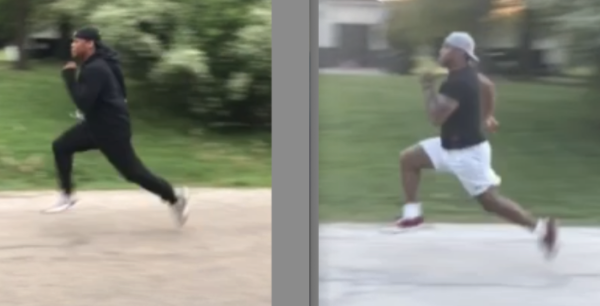
Fine Tuning David Montgomery: Small Changes Have a Big Impact!
If you made it here, you are probably coming from SimpliFaster to see a further breakdown of the video. I will explain what I see in the pre and post video. If you are a TFC follower, sorry for the delay in blogs. The work load at school this year was worse than being a first-year teacher. The film is 60 fps on Coaches Eye. Sorry for the poor quality but coaches eye never seems to transfer over well from my street to my iPad. Sometimes these differences may seem small, but we are looking to improve each segment by .01’s of seconds which add up to .10’s quickly when you take into consideration the multiple steps. Each position also sets up the next for a more efficient gait. But, before we start, let’s get the science out of the way. This all based on Ken Clark’s work. For a full explanation, check out his explanation on YouTube.
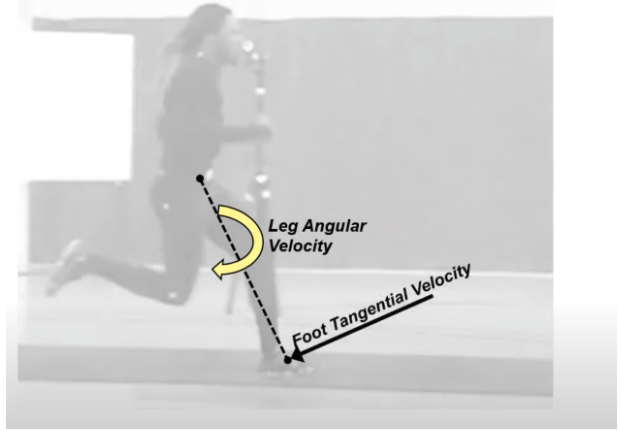
Tangential force is basically the diagonal force that a runner puts into the ground. It is a combination of vertical and horizontal force. Some runners who have too much knee height and don’t run as fast lack tangential force. Nothing pulls their hips forward. Someone who has too much horizontal force will lack the ability to create speed of the limb to pull the body faster because the limb does not accelerate into the ground as fast. The leg has traveled a shorter distance. Additionally, the faster the limb travels, the more energy is created for the system to absorb and put back into the ground. This forces better ankle action and shorter ground contact time. Without the contact angular velocity, the foot needs to stay on the ground longer, causing a push behind which results in a poor pelvic position. See the picture below.
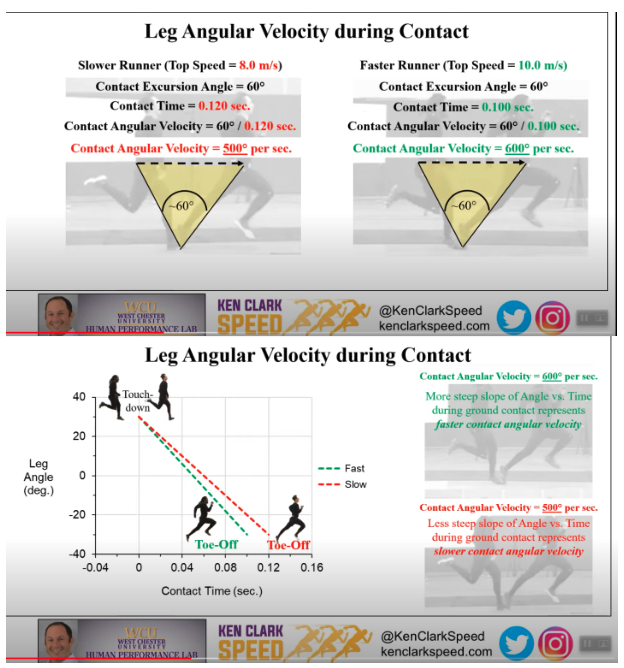
CONTACT LEFT
From video footage:
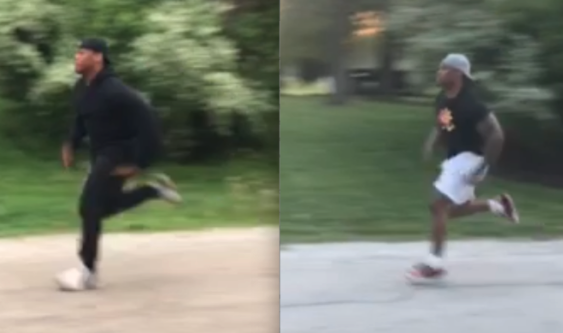
“Pre” is on the left, “Post” is on the right.
Pre: This is first contact with the ground on film. David Montgomery of the Chicago Bears is landing on the outside of his foot which is slightly rolled to its side. He also leads a bit more with his chin. Also, notice the swing leg position. It is slightly behind his plant leg. To me, David is “late in the gait”, which means his timing is slow. This scenario could lead to an early contact with that leg which would act as a brake rather than an accelerator.
Post: This is the same frame number and position in the Gait cycle. The after shows his foot striking in a tangential fashion which means he is pulling his foot in a diagonal direction under his body mass. So, instead of jabbing the ground like a piston creating pure vertical force, he is pulling his body forward with a sweeping leg.
MID-STANCE LEFT
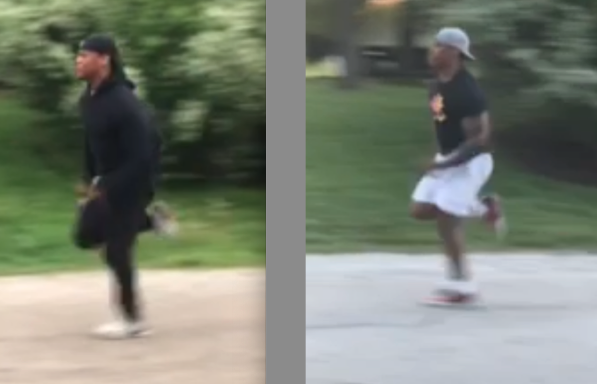
Pre: David is in a decent position with his swing leg but his shin is more vertical than I like which could lead to a late push. This is also indicative of an athlete with a pure vertical force.
Post: Shin angle is improved. More importantly, look how is shin and foot look to be in a more “loaded” position. David’s torso seems to be leading with his heart rather than his chin which creates more of a whole body spring.
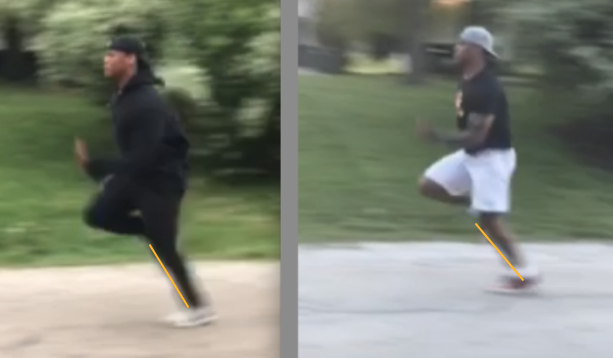
Pre: Starting to load for the push. Ankle angle and shin position could be better as could David’s swing leg carriage. He had a bad habit of stepping wide with his left leg and with his power he constantly had to compensate and redirect from a push across to the right.
Post: This picture looks like David is winding up for the spring forward. The ankle looks more loaded, the shin angle is more horizontal and the carriage is slightly tighter. His left foot is more under his frame instead of outside his frame. The tighter carriage in the swing leg will have a big impact on the next 2 frames. The shorter the lever on the swing leg allows for less energy needs to bring it through or allows for more energy to swing it farther forward.
TOE-OFF LEFT
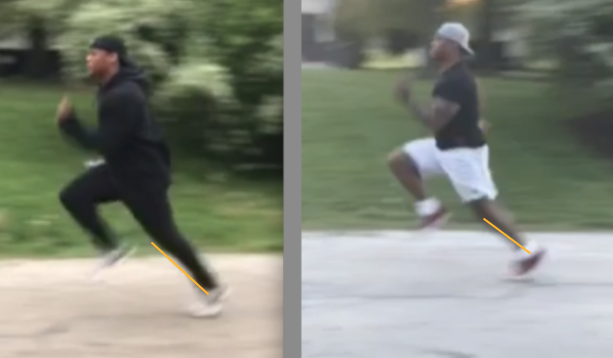
Pre: At toe-off, David’s mass seems slightly behind compared to his post picture. Swing leg carriage could be a little higher. His knee is a little far behind his hip, but it is close. It is straighter than the post frame.
Post: As a result of the swing leg carriage, the knee reflexively swings higher. His heel is closer to his hamstring from before. His shin is slightly more horizontal than the previous. His pelvis is in a better position to bring his leg higher as well. His hips and torso seem to be driven forward as compared to the pre where it seems behind.
TOE-OFF PLUS

Pre: Decent height from the toe off but the lower knee drive will not allow enough time for the leg to sweep under creating Ken Clark’s tangential force (T Force). This will result in a “late in the gait” scenario.
Post: The is the result of slightly better angles. the body is definitely higher than before, the knee is higher and pelvis is in a better position. Again, it seems that David’s mass is being propelled forward. A good marker is an almost vertical strip in his shorts. You can also see an improvement in the angles between David’s thighs. This will result in a positive running scenario which is the concept that if the arc of the thigh split are bisected, the more forward the bisector is, the better the runner. It also gives the runner more of a wind up from the front thigh to T-Force into the ground.
GLIDE
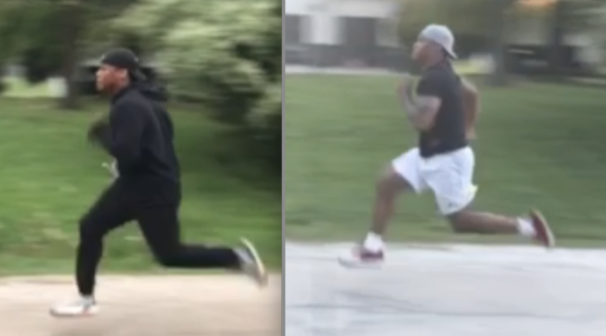
Pre: The “Ken Clark Split” (femurs) is less than 90 degrees. This creates the issue of reversing leg speed back into the ground. Comparing the two pics shows the post as having a greater distance to create force into the ground. This greater speed in the tangential force will make the ankle create a greater spring (shin angle change).
Post: A greater height for him to fall from coupled with tangential force from the swing will create greater propulsion because of the increase of velocity from the swing leg.
PRE-CONTACT RIGHT
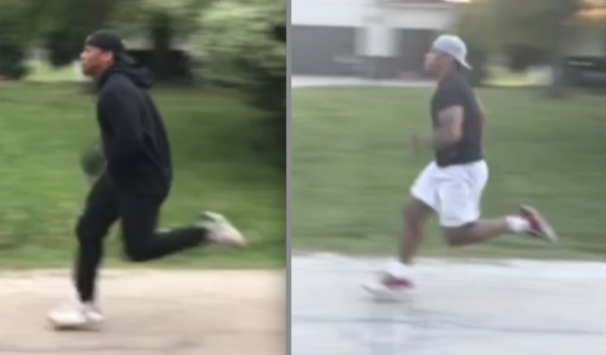
Pre: Foot is about to contact in a vertical fashion, almost like he is stomping on the ground. Also, his foot looks like it is reaching for a pre-contact, force dampening contact. His hips look slightly behind.
Post: This leg looks different, like it is going to sweep the ground. This is where the T-Force comes into play where he can sweep into the ground. That sweep will also create a faster reflex of the swing leg.
CONTACT RIGHT
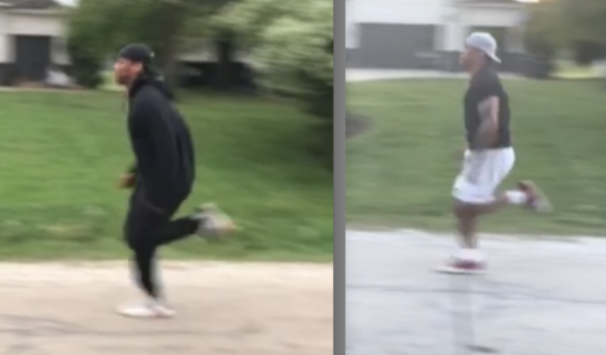
Pre: This is where it starts to get interesting and the timing doesn’t correlate because of the difference in stride length. In the same time frame David is almost at midstance
Post: David has less of a lean at this point. Sometimes, a lean becomes part of the drive. It creates momentum when the leg cannot. When there is intent, the body will find any means necessary to get to the goal. The nervous system knows what is working and what is not.
CONTACT RIGHT PLUS
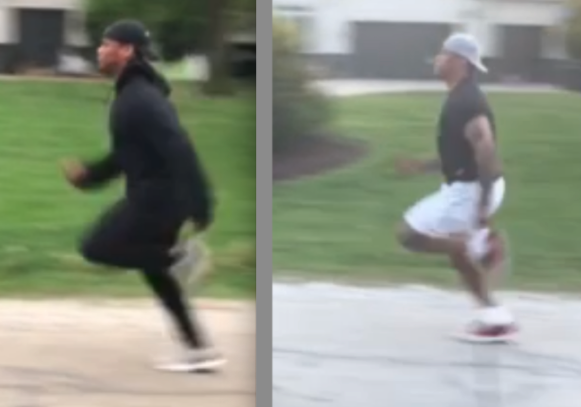
Pre: David is still using lean as a secondary mode of propulsion but overall a good position.
Post: Even though he frames are similar, his ankle angle is improved which is creating a bigger spring.
TOE OFF RIGHT
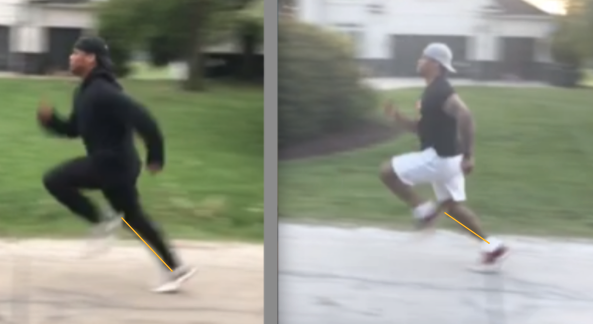
Pre: David is in a decent position but his knee is already fairly straight, his torso also has a slight twist.
Post: Almost identical except for the angle of the stance leg knee. He also has less rotation of the torso.
TOE-OFF RIGHT PLUS
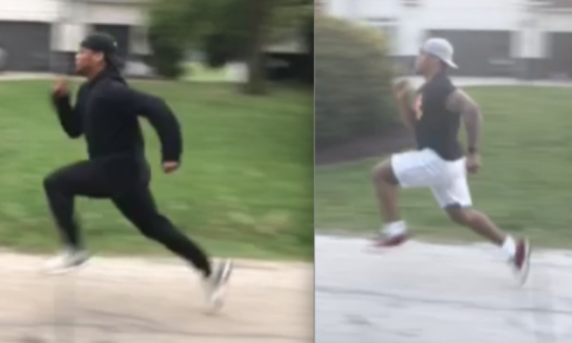
Pre: A good position but David’s knee is slightly behind his butt.
Post: The height and distance of which he pushes is evidently greater than before. And the knee is in a better position. Part of it has to do with is improvement of the rockers in his feet. If the rockers don’t deal with the process of extension and “rolling through” the knee will have to extend more. This is the reason why I use my “Chuck Berry Walks”.
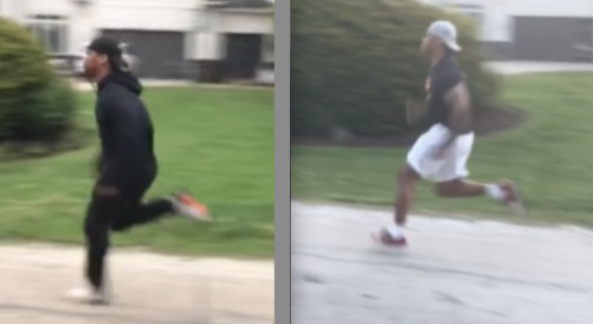
Pre: As you would figure, it looks about the same as the first frame.
Post: Same position in the frame count, David is still in the air, which allows him to create more tangential force.
Besides the drills that I mentioned in Simplifaster, some of the staples we used to make these changes were “Chuck Berry Walks” when we could get outside. I like “Chuck Berry Walks” because it teaches the body to go through the entire rocker process. As I mentioned earlier, the body has to find a way to propel itself with all of the energy that has be stored. The most efficient process is to go through all four rockers, heel, ankle, forefoot and toe. If the body doesn’t feel safe through that whole process, it will extend the knee to skip whatever rocker that is missing. This can have a detrimental effect. The extension of the knee can sometimes, as in David’s case, be too strong for the quadtratus lumborum (QL) to hold the pelvis in place (think RPR recruitment patterns). You can see by the video, David never extends his knees in the post pictures but runs much faster and efficiently. David’s problem with his NFL Combine 40 was that he extended so hard with is knee that his pelvis became unstable which caused energy to go all over the place rather than straight ahead.
Overspeed seemed to fix a lot very quickly. David’s body has the ability to learn rapidly. When I pulled him over mini-hurdles at 10 m/s at a distance of 1.7- 1.9 m, he didn’t have a chance to allow for full extension of his knee and it forced his foot to do the work. We challenged it even more with elevated surfaces and water bags. Once I saw the change in his sprint on the street, we changed our drills.
Also, going through the hurdles, we would focus on bringing the calf to the hamstring as tight as possible. The goal was to shorten the arm (swing leg) as fast as possible. With a shortened arm of the lever, energy is conserved. This extra energy is used to swing the knee further forward.
Again staying in the overspeed realm, we shifted to “Bent Knee Prime Times” and single leg runs. “Bent Knee Prime Times” is really just a running Chuck Berry, forcing all four rockers and your knee to stay under your butt. To take the next step you have to reverse your swing leg and accelerate it into the ground (T-Force).
The Frans Bosch single leg runs work on what your leg is doing in the air. In his recent book on agility, Bosch comments on how the greatest changes in a runner can occur with the leg that is in the air. With the single leg runs, we focus on the cycling as fast as possible and overemphasize the swing leg position. The other leg just serves as a “kick stand” to get you ready for your next step.
We continue to video and make assessments based on what we see in the video and I will keep you updated.
For more videos and explanations, check out TFC 2020 Presentation on the topic.
+++
+++
TFC-TEXAS JULY 9-10, MCKINNEY STADIUM
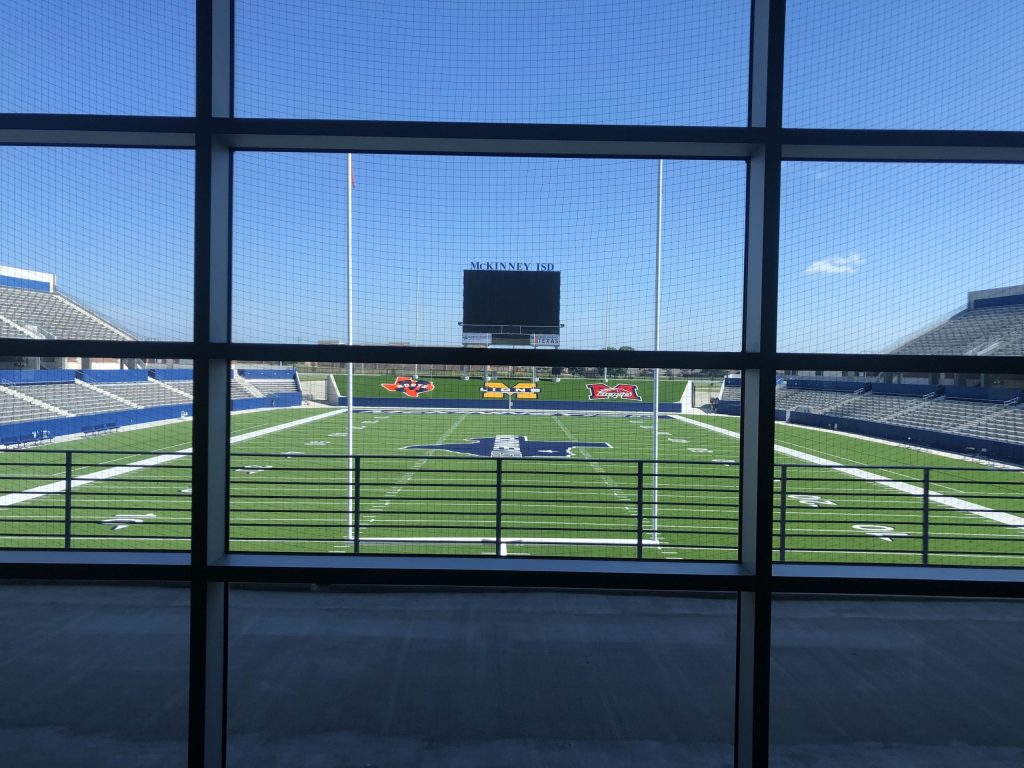
The backdrop for TFC-TEXAS is pretty spectacular!
Tickets still available!
+++
+++
TFC-IOWA JULY 23-34, ANKENY H.S. (2020 IOWA STATE FB CHAMPS)
FEATURING IOWA STATE COACH MATT CAMPBELL.
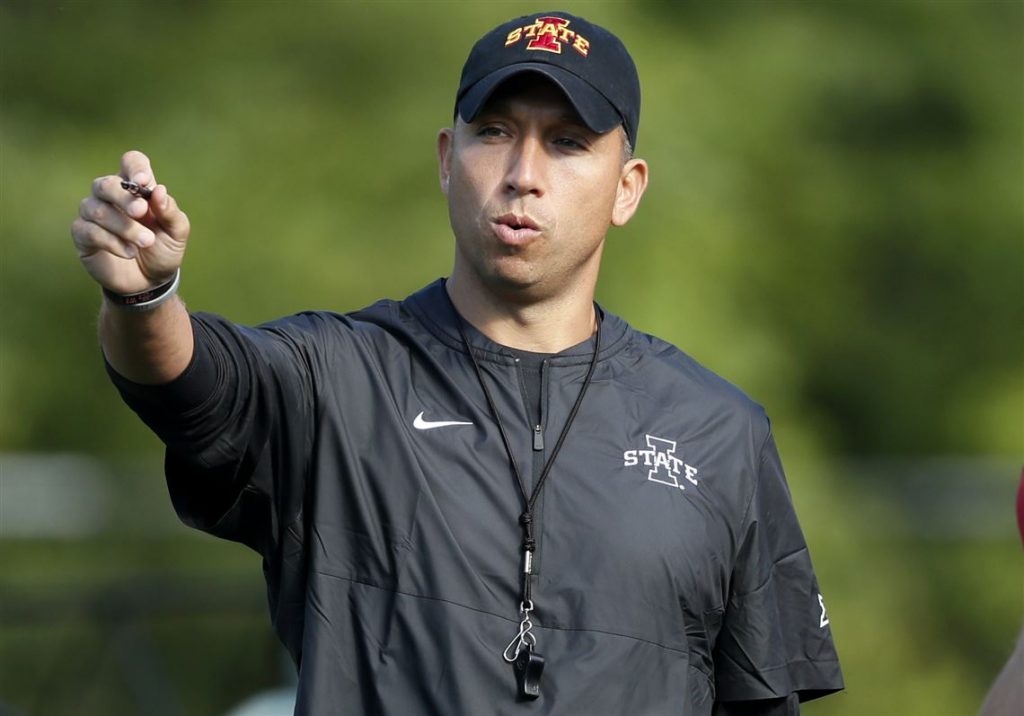
Tickets still available!
